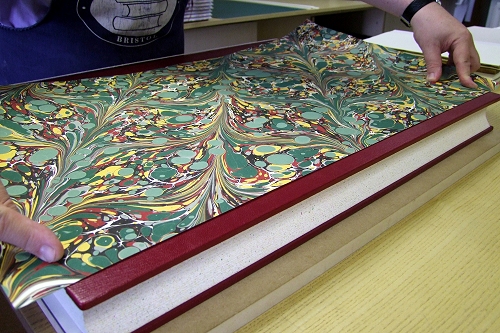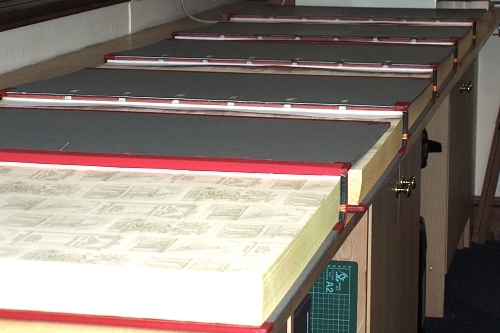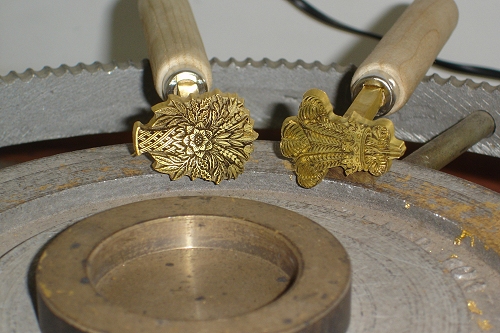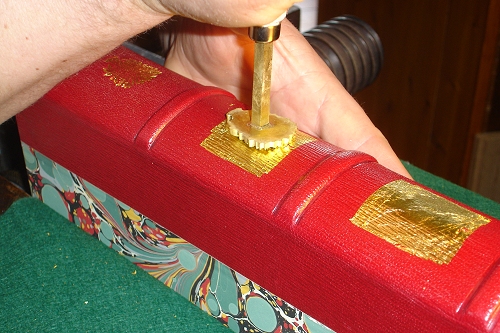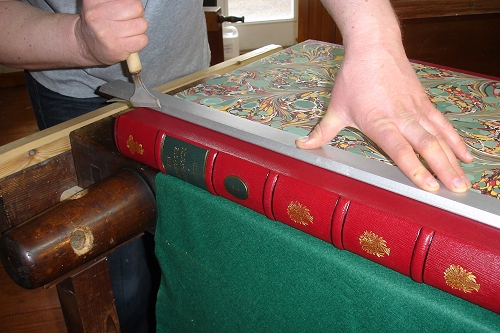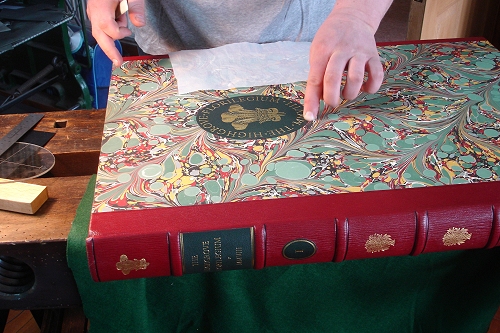
Volume 31 - Spring 2011
The Binding of the Highgrove Florilegium
by Stuart Brockman
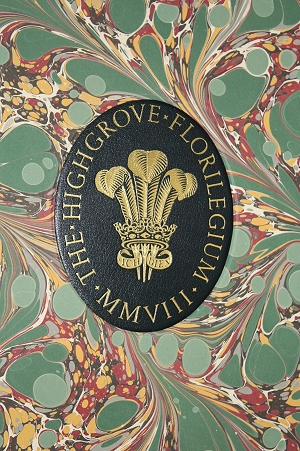 |
'The Highgrove Florilegium will not only provide an historical record of the plants in my garden, but will also be enjoyed by many of those who have an abiding love for plants and gardens'
HRH The Prince of Wales - Taken from the Preface of The Highgrove Florilegium |
The Highgrove Florilegium, published 2008
For seven years prior to 2008, leading botanical artists from around the world were invited to paint examples of the plants and trees growing under the stewardship of HRH The Prince of Wales in his 15 acre garden at Highgrove in Gloucestershire. The selection process for artists had been vigorous with only around 30 per cent of those submitting work being represented in the final volumes. Addison Publications Ltd was asked by The Prince to make a limited edition publication of these 120 watercolours by the 70 chosen artists and The Highgrove Florilegium is the result. The two volume edition is limited to 175 sets. His Royal Highness, who wrote the Preface and holds set 1 of 175, has signed each numbered set. All royalties from The Highgrove Florilegium are donated to The Prince's Charities Foundation.
Contributors to the binding of The Highgrove Florilegium
The production of the bindings is a team effort:
Iain Bain was responsible for the overall book design and typography
using “Fairbank” and “Bembo Book” types. |
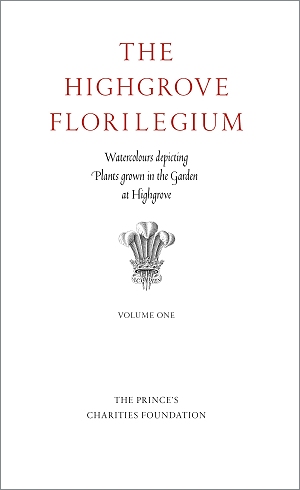 |
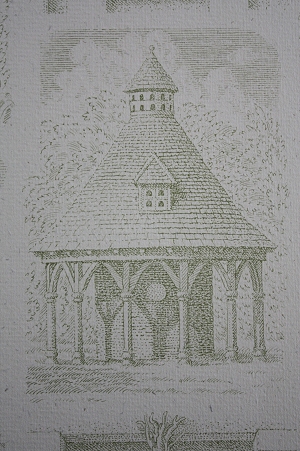 |
Richard Shirley-Smith’s original sketches of motifs from the garden at Highgrove decorate the text and the endpapers. The decorative motifs include plants in the garden, the Princes’ tree house, the dovecote and a flock of Indian Runner Ducks. Richard also designed the finishing tools used on the spines. |
John Parfitt printed both the text and the image pages at the Westerham Press in Kent using Stochastic Lithography, which facilitates the creation of outstanding quality prints from original watercolours. |
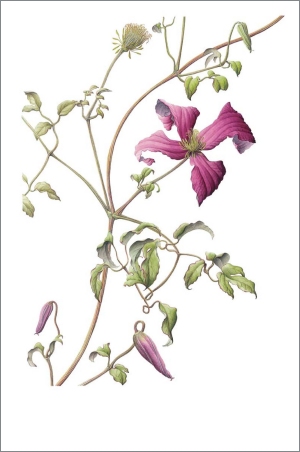 |
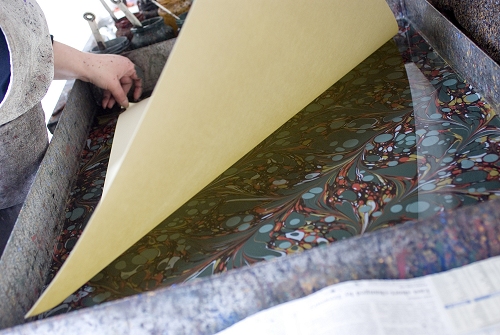 |
Victoria Hall marbles the specially commissioned paper for the bindings. |
J Hewit and Sons provided the leather specially dyed red Straight Grain Goat for the spines and fore-edge strips and dark green Chieftain goatskin for the leather labels. |
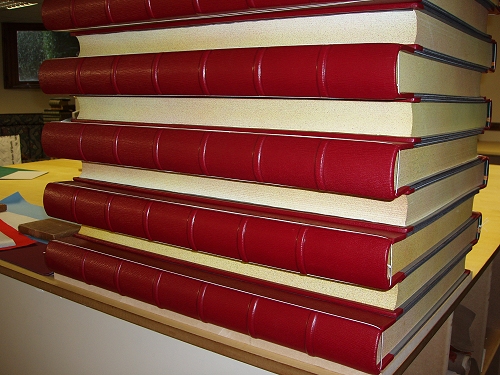 |
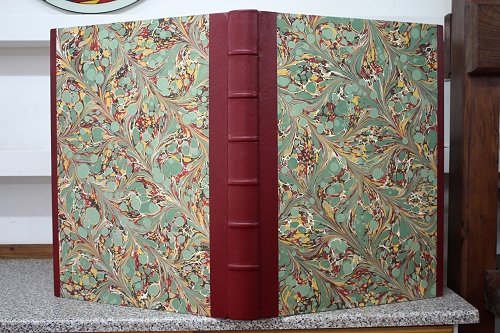 |
Stephen and Fiona Conway and staff at their bindery in Halifax, West Yorkshire carry out the forwarding of the Highgrove Florilegium. |
James and Stuart Brockman undertake the Finishing of the 350 volumes. |
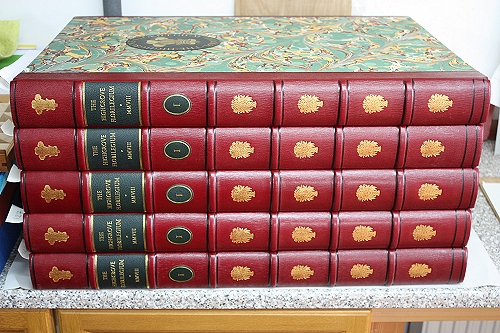 |
Forwarding |
|
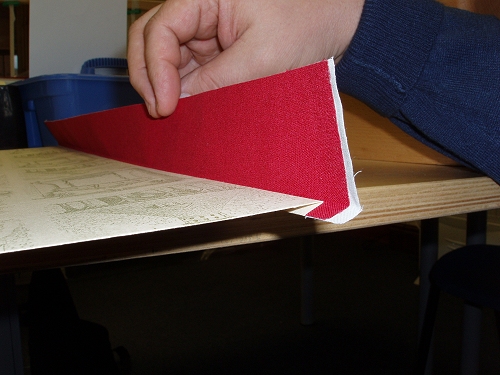 |
With a volume of the scale and weight of the Highgrove Florilegium the structure must be sufficiently strong. Each volume measures 665mm from head to tail, 495mm from spine to fore-edge and 65mm thick and consists of around 60 plates printed on archival quality acid free 100% cotton 245gsm American Cotton paper made by Monadnock Paper Mills in Bennington New Hampshire. Each volume also contains around 70 text leaves printed on 175gsm “Somerset Bookwove” paper made at the St. Cuthbert’s Mill in Wells Somerset.
Endpaper make-up |
The volumes have endpapers of acid free Hannemuhle paper printed with images depicting views from the Highgrove garden, designed by Richard Shirley-Smith. They incorporate both a cloth and a linen joint which when put down on the inside of the boards reinforces the board attachment. All the plates are stamped with the publishers name and the leaves are folded by hand. Prior to sewing each section has the holes in the back edge pre-punched in order to increase efficiency and accuracy during sewing.
Pre-punching sewing holes |
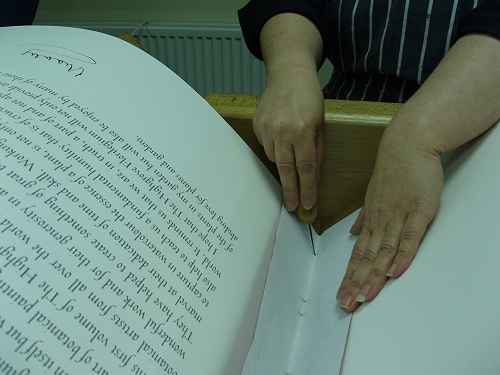 |
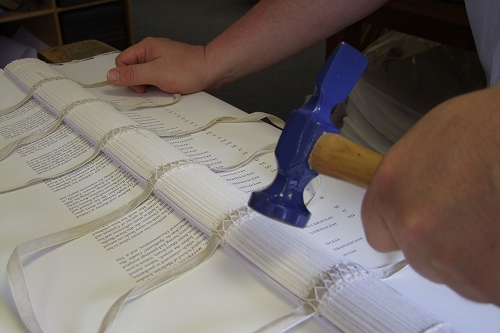 |
The books are then hand sewn on six 10mm linen tapes using a thick 15/4 linen thread to maximise sewing strength and produce enough swell within the sewn volume to permit even rounding and backing. The spines are glued with reversible PVA and rounded and backed with an accurate joint height equal to the thickness of the boards. Rounding and backing a book of this scale is some feat in itself and is an unenviable task! A specially made laying press was obtained to carry out this part of the binding process.
Rounding and Backing |
Each board is made up by laminating 2 pieces of 2mm millboard with a core of 540gsm acid free card and a paper lining on the inside using wheat starch paste to provide rigidity. As the books are difficult to manhandle the fore-edges of the boards are covered with the leather strips prior to the boards being laced on. The boards are laced on with the 10mm linen tapes passing through slots cut at a 10-15o angle through the thickness from the very top edge of the board with a very slim sharp chisel.
Cutting slots in back edge of boards |
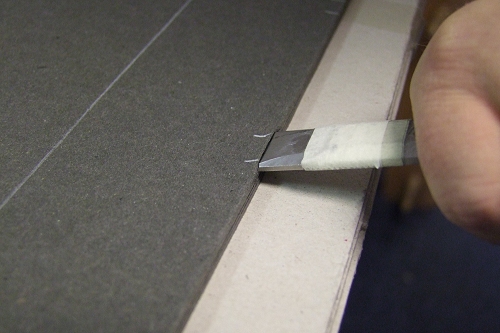 |
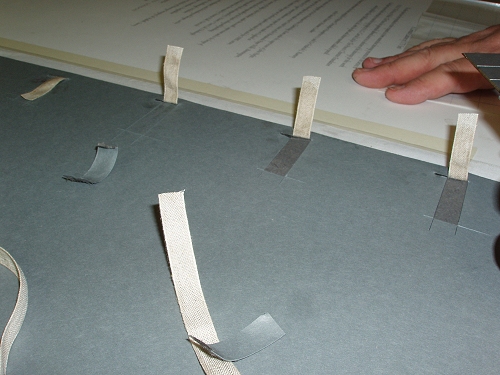 |
The tapes are stuck with PVA into recesses on the inside of the boards and the slots in the board are reconsolidated around the tapes with paste. Endbands are sewn by hand over a leather and vellum core incorporating numerous tie downs to add strength to the sewing structure at the caps of the volumes. The colours used pick up on those used by Victoria for her marbled paper.
Slots for recessing tapes on inside of boards |
The spines are lined with 3 layers of acid free Kraft paper followed by a 3 on 4 off hollow (totalling six layers of paper adhered to the book and four layers forming the free section). Leather false bands are added to the spine in the exact same position as the linen tapes used for the sewing supports.
Adding False Bands |
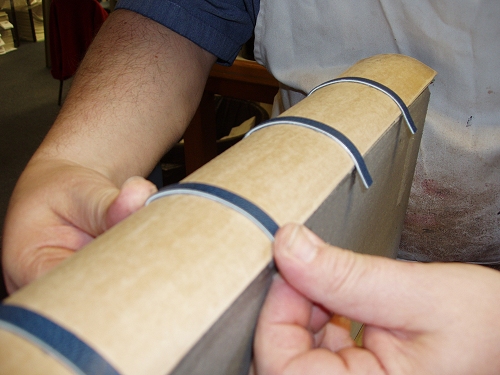 |
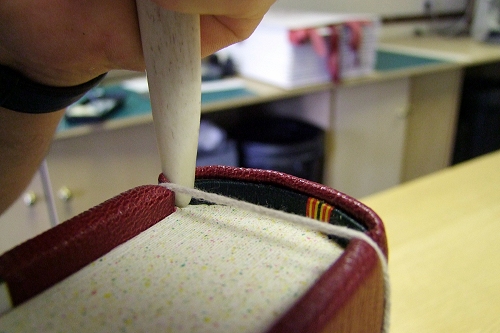 |
The spines are covered using paste to consolidate the leather as much as possible in order that the finishing impressions are as sharp as possible. During covering, the book is tied up, pulling the leather into the back-cornering - this assists in forming sharp caps.
Setting the caps |
The sides are filled in with an acid free 350gsm card, the front piece having an oval section removed to achieve a recess for the label on the front board. The oval is cut using a Perspex template – Stephen has one in Halifax and I have another in Oxfordshire. Stephen’s template is 2mm larger than the one I use to cut out the labels, this difference allows for the thickness of marbled paper and a small amount of flexibility when adhering the label to the front board at the very end of the binding process.
Cutting the oval recess for the label on the front board |
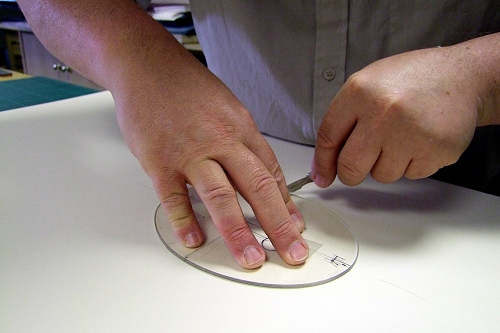 |
The books are sided with marbled paper and the cloth joints put down on the inside of the boards. Finally the pastedowns are added – these are again printed leaves depicting Richard Shirley-Smith’s sketches. The final stage in Yorkshire is to check the books over, then wrap and ship them to my bindery in Oxfordshire. |
|
Siding with marbled paper |
Putting the joints down |
Anyone who has forwarded a volume of the size of the Highgrove Florilegium knows what a challenge it can be, so for Stephen to superbly forward 350 volumes on this scale is a truely magnificent achievement. Actually we have to date produced around 250 – only 100 to go!! FinishingThe books usually arrive in Oxfordshire in batches of 10 or so by carrier. Each box weighs around 11Kg. The lettering, volume numbers and labels for the front board are blocked using gold leaf. The leather is pared thinly (typically 0.3mm) and mounted on acid free paper (120gsm) with paste – as with the covering procedure the paste consolidates the leather and helps achieve a sharp clean impression during blocking. The labels are cut to size – using templates for the lettering and front oval label, but by eye for the volume number.The labels are then edge pared to prevent any of the white backing paper showing around the edges of the labels and to provide a smoother transition from one level to another once they are stuck on. |
|
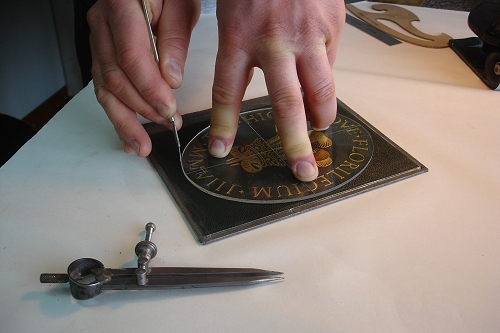 |
Cutting the front label out |
Cutting the volume number label out |
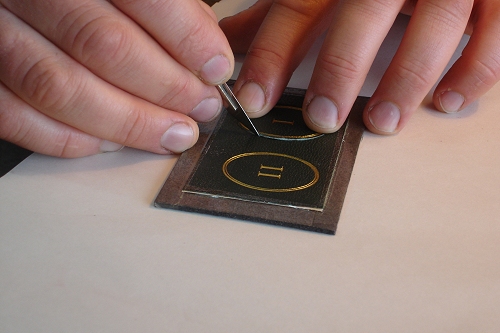 |
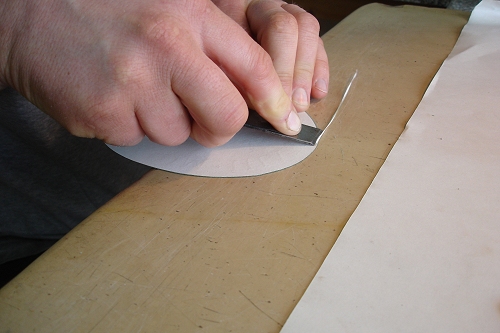 |
Edge paring the oval label |
| The surface of the straight grain covering leather is scratched in the positions of the labels to aid adhesion, and the spine labels stuck on with reversible PVA. The oval volume number has a recess impressed into the covering leather so as to appear like an inlay rather than onlay – again trying to avoid sharp edges between covering leather and label. Lines are marked across at head and tail using a bone folder and a strip of vellum to act as a guide for tooling the blind lines later. | |
| With the volume held tightly and low down in a large laying press, the spines are coated with B.S. Glaire that is allowed to dry for an hour or so. A thin coat of Vaseline is then applied to temporarily hold the gold leaf in place until tooling has taken place. The gold leaf is then cut into squares and laid on. A double layer of gold is applied on the spines in the approximate positions of the centre tools. The finishing tools, designed by Richard Shirley-Smith, were made by Fine Cut. The heated tools are cooled to around 100°C on a wet cotton wool pad, polished on a calf leather pad and then impressed into the spine, using a rocking action to compensate for the curvature of the spine. The tools, which are incredibly detailed require very careful positioning, they are approximately 35 x 28mm and require a great deal of time to warm up sufficiently.
Spine with gold laid on |
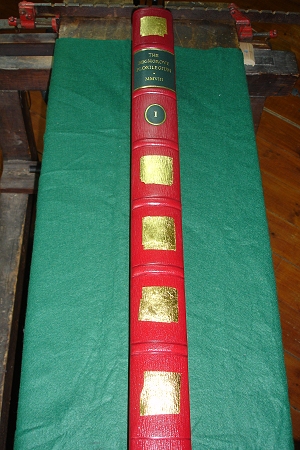 |
The two finishing tools |
Making a good impression |
Once all the first impressions are made, the Vaseline layer and therefore the excess gold leaf is cleaned off with lighter fluid and cotton wool. More vigorous cleaning is then carried out with a rough duster or similar cloth, and once again using a small amount of lighter fluid.
|
|
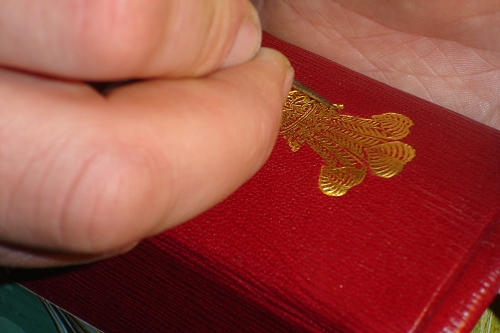 |
Virtually every first impression is not sufficiently intense, so subsequent applications of gold is necessary to achieve the required bright solid result. The tools, particularly the Prince of Wales feathers, are very difficult to put in again, due to their size and lack of sharp distinct points to guide the tool into the previous impression. At times in order to achieve a perfect result, the tools need to be impressed again and again with additional layers of gold leaf. The additional impressions are by far the most stressful part of the finishing process, especially when the binding has been forwarded by someone else – there is huge scope for spoiling many hours work – mainly Stephen’s! When the tooled images are solid there is a small amount of final cleaning out with a pin.
Cleaning out with a pin |
Once the centre tools are in, the blind lines are tooled against the bands and at head and tail by using a heated pallet and rubbing in the impression. They are coloured black using permanent Indian ink. After the spines are tooled the books are on the home straight. To tool the lines up the sides of the bindings I use a straight edge and a hot flat pallet slid along it with the leading edge tipped upwards to avoid digging into the leather. Again these lines are coloured black with ink. The oval label, edge-pared on the back earlier, is now stuck into the recess on the front board – squarely to the board edge. The very edge of the label is folded down – again to give a smooth transition from marbled paper to label rather than a sudden step. |
|
Blind tooling the lines up the side |
Adding the label to the front board |
The binding has a final check over and is then wrapped ready for collection. . All images are reproduced with the kind permission of Addison Publication - © A G Carrick.
Stuart Brockman – was born in Cambridge in 1972. He graduated Imperial College 1994 with a BEng Mechanical Engineering degree. He trained as a bookbinder with his father James, with whom he works with on Designer Fine Bindings and the conservation of manuscripts and early printed books. |
|

